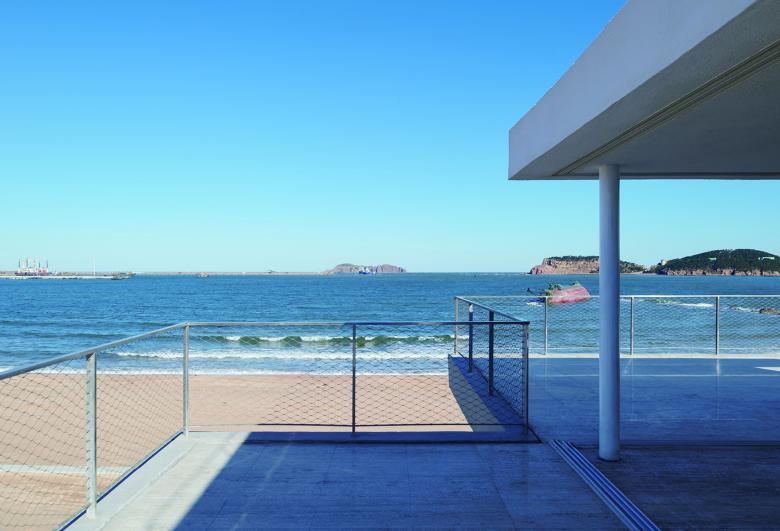Seaside Floating Pavilion
Torna enrere a la llista de projectes- Localització
- Rongcheng, China
- Any
- 2021
At the easternmost tip of the Jiaodong Peninsula, an abandoned fishing boat ran aground near an undeveloped natural bay area. The scour marks on the fishing boat made by waves becomes marks of the time; the boat is leaning, as if overwhelmed by the ravages of the sea and about to capsize. Between movement and stillness, life and death constitute a picture of eternity and instantaneousness.
Such poetic scene evokes the imagination of a floating pavilion -a small and lightweight flying object that glides onto the beach and seems ready to leave at any time- which respond the vastness and emptiness with its slenderness and smallness, and respond to eternal weight with its lightness of instantaneousness.
The main feature of the building is a plane that extends horizontally and opens up to the sky. The plane provides space for the main functional area above, and creates a semi-outdoor space below which is supported by several elements in various shapes, resembling a pavilion. As such, this horizontal plane has dual properties, it is not only the roof that provides visitors with a sheltered space, but also a high point to enjoy a panoramic view of the surrounding landscape.
Just like the wings, the cantilevered horizontal plane presents a posture of flying, creating a sense of ambiguity between the building and site. Part of the cantilevered slab is inclined which gives the building an unstable state -as if it has just landed and gazing at the sea, and it seems to be leaving the next moment. The moment of time seems just happened to freeze on the building.
The building is elevated on a few geometric components to open up the ground floor spaces, which allows visual and physical continuity and enhances the sense of floating. Circular and curved forms, as well as inclined staircases, give the building a dynamic sense of instability.
The journey of the building begins with a long walk through a soft sandy beach. When stepping on the solid concrete floor, the space gradually lowers and opens to the sea and beach. A circular toilet, a square table and an arc-shaped open bar are three elements that make up the space. The sea level in the distance is being cut, framed, and defined by these elements, becoming the focal point of the space.
Up to the second floor from a narrow straight flight stairs that running through the cantilevered slab, it comes to an open viewing platform, overlooking the sea to the north and the village to the west. Sliding glass walls are used for a more flexible space. When fully opened, it connects the indoor and outdoor areas, providing a spacious viewing and dining platform for such compact building. The logistics and the stairs to the roof are half-hidden on the inner side of the inclined slab. In minimal plan layout, the service space and served space, visitors circulation and logistics circulation are clearly separated by the slabs that are inclined at different angles.
The rooftop platform marks the end of the journey, where the horizon and sky connect and one can enjoy a panoramic scenery of the bay, beach, hills and villages. A set of steps and chimney form a pyramid-shaped sculpture, pointing upwards to the sky.
In response to the concept of horizon, the construction technique and materiality of the building also follows such formal logic. Grey micro-cement is used for the finishing surface of the primary horizontal plane to create a sense of heaviness like concrete; steel structure is adopted in order to achieve a huge cantilevered form. Such illusion between visual effect and real architectural construction is created to strengthen the dramatic tension of the building.
Different materials also emphasize the variation in vertical direction. Grey micro-cement is used in the ground floor, which echoes the surrounding rough natural beach, creating a relaxing and casual atmosphere; light- colored travertine is applied for the ground of the second floor to reinforce the image of floating and elegant; the volume on the upper floors is decorated with white washed stone, creating an abstract perception. One will have varying views and experiences as ascending from the ground to the sky and horizon.
Circle, triangle, arc, square, plane, inclined rod... The floating pavilion is made up of these "components" that in various geometrical shapes. Not only build up the architectural form, the “components” are also designed to meet the structural and functional needs of the building. For instance, the staircase is also served as a bracing for resisting lateral forces in the building. At the same time, structural elements such as columns, bracings, floor slabs are fully or partially hidden inside the “components”, or become the “components” themselves. They are no longer pure structures that serve only spatial and functional purposes, but are also endowed with formal meaning, and become an organic part of the architectural language.
When the conventional architectural language is being decomposed, the architecture becomes an “object” which in the state of something more primitive: the Floating Pavilion, just like the abandoned fishing boat, comes here by chance and defines the bay.





